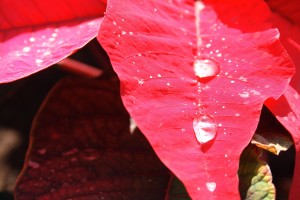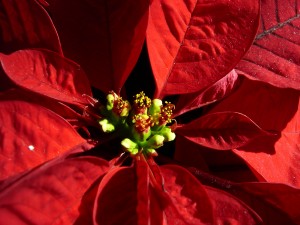If you are looking to include the Poinsettia in your Christmas tradition, or if they have long since become a staple when you ring in the holidays, we have compiled some key tips, tricks and information on everything you need to know to keep your Poinsettias blooming for years to come!
Although the plant only blooms once a year during the Christmas season, with the proper care and attention your Poinsettias will continue to grow every winter. However, Poinsettia care can be an exacting process so it is important to know exactly how to plant, grow and nurture these blooms. Here are some helpful instructions and information on caring for indoor Poinsettias. In our next post, we will be detailing the care and process of maintaining Poinsettias planted outdoors, so be sure to check back soon!
Indoor Poinsettia care
Bringing it home: When you first bring your new Poinsettia home, it will likely already be potted and in bloom. Place your plant near a window that gets a lot of sunlight—Poinsettias are tropical plants and flourish in large doses of sunshine.
The tropical nature of the Poinsettia creates the need for temperatures above 60 degrees Fahrenheit. Anything cooler than this can result in premature leaf falling.
The Poinsettia lets you know it’s thirsty when its surface feels dry to the touch. When watering the plant, let the water drain to the bottom—but don’t let your plant sit in the water or it will wilt. If wilting does occur, don’t fret! Wilted Poinsettias can be revived, but it can take another season to restore it back to its lush appearance.
If your home is lacking in humidity during the dry winter seasons, you will need to keep a close eye on the Poinsettia and might even need to water the plant on a daily basis.
Post-season care
During the early months (January, February and March), continue to water the Poinsettia whenever its surface feels dry. In April you can begin to decrease how much you water the plant and letting it get dry between each watering. However, keep an eye on the stem—if it begins to shrivel, this means that the plant is stressed and could be dying.
Once the plant has become accustomed to the decreased watering and drying system, you can place the Poinsettia in a dimly lit area such as the garage. Be sure to keep the temperatures around 60 degrees Fahrenheit.
In May, cut the stems back 4 inches, repot the Poinsettia in a slightly larger container in new soil and water well. Put the plant on or near your brightest window and resume the original watering system of watering every time the plant feels dry. When you begin to see new growth, fertilize the plant once every two weeks with a fertilizer that contains all three major plant nutrients (usually referred to as a ‘complete fertilizer’).
In a month or so, move the Poinsettia (in its pot) outside to a partially shaded area and continue to water and fertilize. To keep the plant from growing too tall and frail, pinch the stems back by one inch.
Plantman tip: “Pinching” is done when a plant has very crisp and slender stems that allow you to remove the dead parts with your fingers. This is done with coleus plants that have thin stems, as coleus plants are grown for their foliage rather than their flowers. Pinching these plants promotes fuller foliage.
During the August and September months, you should begin to notice that your Poinsettia has branched out. When this happens, you will need to pinch the new stems back once more, being sure to leave at least 3-4 leaves on each stem. You can now bring your Poinsettia back inside to a bright window and continue your normal watering and fertilizing routine.
Bringing your Poinsettia back to Christmas condition
Once the winter season rolls back around, usually in October or early November, the real work begins. In order for a Poinsettia to begin re-blooming, it will need 12 hours or less of sunlight per day. This is essential for the plant to blossom. You will need to keep your Poinsettia in a dark area for at least 12 hours a day—between 5 pm and 8 am is a good rule of thumb. If the plant is exposed to even slightly more than 12 hours of light a day, its blooming will be delayed and its bud set will be affected. Continue to water and fertilize.
You can begin keeping the plant near a sunlit window full-time again around the end of November—and bask in the beautiful blossoms that you have helped grow throughout the last few months!
Completing the Poinsettia cycle
Around the middle of December, you can continue to water the Poinsettia per usual but you should cease fertilization. If you have been diligent about your Poinsettia’s care, it should be in full blossom just in time for the holiday season! And at the end of December, simply repeat the process you just completed for beautiful Poinsettia blooms next Christmas.
References: http://gardening.about.com/od/winterinthegarden/a/Poinsettia.htm



